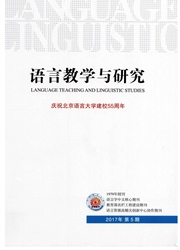

 中文摘要:
中文摘要:
本文考察了“差点儿”和“差不多”中所含的隐性否定的语义层次,比较了这两个副词在语义结构诸层面(断言、推论、预设、情态)上的同异,得出结论:(i)“差不多VP”和“差点儿vP”的预设意义相同,都是“接近VP”;(ii)“差点儿VP”的推演意义是“没有VP”,断言意义是其预设和推演的合取;整个格式的语义区间由预设标定下限,由推演标定上限;(iii)“差不多vP”的推演意义是“不一定正好是VP”(包括:“没有达到VP,’、“超过了VP”、“正好是VP”),断言意义也是其预设和推演的合取;(iv)“差点儿VP”表示道义情态(庆幸/遗憾),“差不多VP”表示认识情态(不确信/委婉)。
 英文摘要:
英文摘要:
This paper examines the semantic level of the implicit negation contained in the ad- verbs chadianr (nearly) and chabuduo (almost), and compares the semantic similarities and differ- ences of the two adverbs at various levels such as assertion, inference, presupposition and modality. It concludes that: (i) the two adverb constructions "chadianr + VP" and "chabuduo + VP" have the same presupposition "close to VP" ; (ii) the entailment of the construction "chadianr + VP" is "has not VP", and the assertion of the construction is the conjunction of its presupposition and its entailment; and the semantic interval of the construction is lower-bounded by its presupposition and upper-bounded by its entailment; (iii) the entailment of the construction "chabuduo + VP" is "does not just VP" ( includes : "less than VP", "more than VP", and "happens to be VP" ), and the as- sertion of the construction is the conjunction of its presupposition and its entailment too ; (iv) the modality of the construction "chadianr + VP" is deontic (rejoice vs. pity), and the modality of the construction "chabuduo + VP" is epistemic ( not sure or understatement rhetoric).
 同期刊论文项目
同期刊论文项目
 同项目期刊论文
同项目期刊论文
 期刊信息
期刊信息
